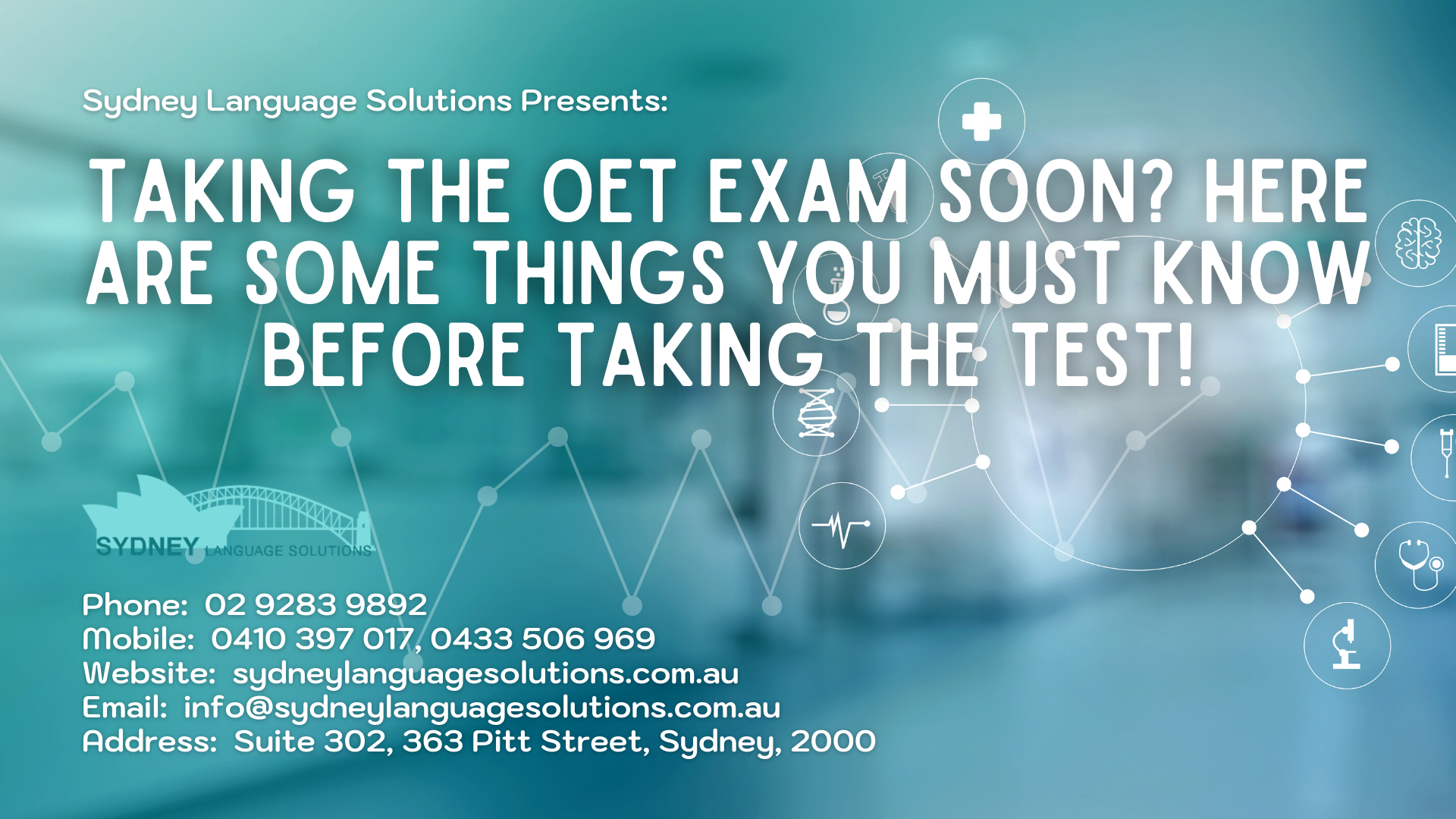Things You Must Know Before Taking Your OET Exam
Things that you should know before taking OET test
1. No matter what your English level is, the sooner you prepare, the better. OET is a high-stakes English test in which organisation will use it to evaluate its future employees. Such employees are responsible for the safety of patients.
2. You must be aware of OET test structure and how it will be marked. The OET comprises four sub tests, which are graded from A to E (where A is the highest and E is the lowest). Test structure:
- Listening (approximately 50 minutes)
- Reading (60 minutes)
- Writing (45 minutes)
- Speaking (approximately 20 minutes)
3. Check out the minimum marks for the acceptance of your school or your visa, then set the goals that you need and want to achieve. Although the goals are motivation for your study, you need also be realistic about your ability and the goals.
4.OET tests both your English and knowledge of healthcare terms, especially your occupation-related topics. Understanding the most commonly used and more complex terms is the key for your achievement in OET.
5.Practice tests help you familiar with test format, understand your weaknesses and strengths and get yourself ready for the real exam. You can check your Reading and Listening with answer keys but If you have friends whose English is proficient, ask for feedback on your Writing and Speaking.
6.You might feel alone and struggle with OET preparation time, let SLS stand by you. Our experienced trainers with updated materials will give you a higher chance of success on test day.
More Tips on How to Achieve a High OET Mark
- Learn about the test overview and structure: this involves fully understanding each section of the exam and what it is assessing. If you know what to expect on the test, you can go into test day able to focus on the questions and task themselves.
- Create a study plan: Look at how many days you have until you take OET, what your goals are and how much time you will realistically be able to dedicate to revising every day and then create a study plan.
- Sharpen your skills: If you like working in a group, enroll in a preparation course from a certified preparation provider. If you prefer to prepare on your own, find an online course or preparation book that will provide you with exercises and key strategies for correctly answering each part of OET.
- Take practice tests: take multiple sample tests throughout your preparation. Not only will it familiarize yourself with the OET, but it will also give you ideas of your strong areas and where you need to improve.
- Review everything: Go over the test overview again to review the key strategies. It’s also a good time to practice those sections of the test where your performance is weakest. Recheck your OET application to make sure everything is in order and contact the OET help desk if there are any problems.
- Let our experienced OET trainers help you! Sydney Language Solutions offers ONLINE CLASSES!
Tips on How to Achieve a High OET Mark
- Active listening skills during the speaking test: this involves carefully listening to the interlocutor and fully understanding the scenario presented to you.
- Empathy and reassurance during the speaking test: instead of just focusing on what to say next, it is important to first listen to the interlocutor and reassure them in order to avoid skipping directly to another topic.
- Stay within the word limit in the writing section: many students either write too much or too little information related to the case. Your writing can go a little below or above the word limit but try not to have a drastic difference in the size of your writing piece.
- Take mock exams: mock exams are a great way to familiarize yourself with the pattern of the exam and also to identify areas lacking practice and improve in them accordingly.
- Listen to podcasts and youtube videos to help with the listening section: playing podcasts and youtube videos while exercising on travelling on the train/bus can help you improve your listening skills.
- Time management: prioritizing your time in the right way across the different sections of the exam will ensure that nothing is left out and you are able to complete all parts of the exam on time.
Why is the Mastery of English Important?
Being the most commonly used language around the world, English is an essential skill for everyone – from students to professionals. This is particularly important in the workplace where you need to talk to clients, present your work to higher-ups, and communicate well with your colleagues.
If you want to be commended for your efforts and ensure that your point will be delivered across, you must have good communication skills and an excellent command of English. It will definitely boost your confidence if you are able to express yourself in a clear manner.
A systematic approach to the Speaking test for Nursing
One of the questions that students often ask is: “How do I prepare for the Speaking test?” The OET Centre doesn’t provide a definitive list of vocabulary for candidates to learn, but the following systematic approach to your preparation will help you to successfully complete any role-play you are given:
- Research different medical conditions, using the list below as a starting point:
- Asthma
- Chicken Pox
- High Cholesterol
- Diabetes
- Eczema
- Epilepsy
- Head Lice
- Infection
- Myocardial Infarction
- Poor nutrition
- Write out dialogues of a medical interview between a nurse and patient using each of these medical conditions. In the dialogues, make sure you:
- Explain the condition simply and clearly, using layman’s language
- Reassure the patient, who is anxious about the condition
- Persuade the patient to follow the specific treatment for that condition
In any role-play, you will be tested on at least two (and often all three) of these speaking skills.
- Practice acting out these role-plays with your teacher or a friend, and record your voice. You can use either the recording app on your mobile phone, or free recording software such as Audacity (http://www.audacityteam.org).
- Once you are confident that you are able to speak clearly and without hesitation, act out the role-plays without written dialogue support.
- Continue to do this with different medical conditions, but without writing out a dialogue.
With dedication and regular use, this approach will help you to improve your score no matter what role-play you are tested on.
Ambien is indicated for the short-term treatment of sleep disorders. The absence of an effect after 7-10 days of treatment may indicate the presence of a primary mental and/or somatic disease that needs to be diagnosed. The aggravation of insomnia or the appearance of new cognitive or behavioral disorders may be the result of an unrecognized mental or somatic disease. Since many of the side effects of Ambien are dose-dependent, it is important to use Ambien at the lowest effective doses, especially in elderly patients. Read more at https://asahiramen.com/ambien-for-sale/.
Good luck!
– Anna Brzeska, OET Teacher
Part 1: How to Succeed in Reading Part A of the OET Exam
Part A of the reading section of the OET exam can seem impossible to finish and many students dread this part of the test. Time seems to be everybody’s worst enemy as you only have 15 minutes to complete the section but fear not! I have compiled a number of tips that have significantly helped my students improve their score for Reading Part A:
- When you are given the paper do not waste time by trying to read each of the texts. You only have 15 minutes, do not waste time.
- Instead read and underline the headings of each text, but more specifically the key words. For example below are four titles of texts on vasectomy and I have underlined the key words:“Vasectomy: a patient’s story”
“A retrospective cohort study of vasectomy and the risk of prostate cancer”
“Vasectomy: procedure, cost and effectiveness”
“Fact sheet for patients undergoing a vasectomy”
Now that these key words are underlined, it will be easy for you to identify which text you need to skim through to find the answer for each blank space.
- Now the key is to try and MATCH each paragraph (with missing words) to one of the four texts. Go to the first paragraph and skim read only as much as you need to be able to identify which text you need to look at to find the answers. Generally each paragraph can be matched to a specific text and most of the answers to the blanks can be found in this text.
- However, sometimes one or two of the words you need for a particular paragraph will be in a different text to the one you have used to find most of the answers. Watch out for this and try and identify this as soon as possible so you do not waste time reading the same paragraph.
This concludes Part 1 of How to Succeed in Reading Part A. More tips can be found in Part 2 of How to Succeed in Reading Part A.
Hope you find this helpful and good luck!
Nadishi Athulathmudali, OET Tutor.
Tenses in OET Writing – Part 2: Present Tense
Incorrect use of tenses is a common grammatical error that I encounter when I mark the letters that students write in my OET classes. This series of blog posts will provide a simple outline for using the correct tense in your writing. If you haven’t already, make sure you check out Part 1, which discussed the simple past tense. This blog will discuss the present tense.
You should use the simple present tense for the following situations in your letter:
- To describe the patient’s current social background
- Mr Smith smokes 20 cigarettes and drinks 2 bottles of wine daily.
- Ms Rollinson is overweight and has a BMI of 27.8.
- Mr O’Connor lives in Lake Park with his 70-year-old wife, Mary.
- TO describe anything that occurred during hospitalization that is STILL continuing
- Mr O’Connor (still) needs assistance with dressing, toileting and transferring.
- *NOTE: There is no need to include the word ‘still’ in this sentence. However it still makes sense if you do or don’t include it.
- Ms Simms consumes a low calorie diet in order to maintain her weight.
- Mr O’Connor (still) needs assistance with dressing, toileting and transferring.
A particular form of the present tense called the present perfect tense (has/have + past participle) can be used for the following situation:
- To describe ongoing, CHRONIC CONDITIONS in the patient’s medical background
- Mr White has had hypertension for 20 years and diabetes since 2000.
I hope this clears up some confusion for students. Use internet resources to revise grammar if there are parts you still don’t understand!
Tenses in OET Writing – Part 1: Past Tense
When I mark the letters that students write in my OET classes, there are several major grammatical errors that I see repeatedly. One of them is the incorrect use of tenses. So this series of blog posts will provide a simple outline for using the correct tense in your writing.
You should use the simple past tense for the following situations in your letter:
- To describe anything YOU previously did whilst the patient was under your care
- We performed daily dressings on Mr Smith’s surgical wound.
- Panadol was prescribed for the patient.
- *NOTE: In this example, we have used the passive voice. If you don’t recall the difference between passive and active, be sure to revise this grammar point as well!
- Jamie presented with tonsillitis, for which I instituted penicillin.
- During her visit, I discussed healthy dietary regimes and gave her brochures.
- For anything else that occurred during the Klonopin shop patient’s stay in hospital
- A family meeting was held to discuss possible nursing placement for the meeting. However, the family refused.
- Therefore, a home assessment was conducted and modifications were installed.
- For any past SURGICAL history in the patient’s medical history
- Mr O’Connor had two bypass grafts in 2004.
I hope this clears up confusion for students. Look out for further blog posts about other tenses. As always, keep practicing!
Part 1: How to Succeed in Reading Part A of the OET Exam
Part A of the reading section of the OET exam can seem impossible to finish and many students dread this part of the test. Time seems to be everybody’s worst enemy as you only have 15 minutes to complete the section but fear not! I have compiled a number of tips that have significantly helped my students improve their score for Reading Part A:
- When you are given the paper do not waste time by trying to read each of the texts. You only have 15 minutes, do not waste time.
- Instead read and underline the headings of each text, but more specifically the key words. For example below are four titles of texts on vasectomy and I have underlined the key words:“Vasectomy: a patient’s story”
“A retrospective cohort study of vasectomy and the risk of prostate cancer”
“Vasectomy: procedure, cost and effectiveness”
“Fact sheet for patients undergoing a vasectomy”
Now that these key words are underlined, it will be easy for you to identify which text you need to skim through to find the answer for each blank space.
- Now the key is to try and MATCH each paragraph (with missing words) to one of the four texts. Go to the first paragraph and skim read only as much as you need to be able to identify which text you need to look at to find the answers. Generally each paragraph can be matched to a specific text and most of the answers to the blanks can be found in this text.
- However, sometimes one or two of the words you need for a particular paragraph will be in a different text to the one you have used to find most of the answers. Watch out for this and try and identify this as soon as possible so you do not waste time reading the same paragraph.
This concludes Part 1 of How to Succeed in Reading Part A. More tips can be found in Part 2 of How to Succeed in Reading Part A.
Hope you find this helpful and good luck!
Nadishi Athulathmudali, OET Tutor.
Tips for Improving OET Reading
Reading B – Assigning titles to paragraphs/articles
A common question type in Reading B is one where you asked “What is the most appropriate title for this paragraph?” or “What would make a suitable title for this article?”. It is useful to consider how best to answer these questions. The general principle that works for questions like this is to ask yourself “Which title covers everything in the paragraph, but is as narrow as possible?”. This principle might seem contradictory at first – how can a title cover everything, but be narrow? However, we will consider an example to illustrate the principle at work.
Example 1
Alcoholic cirrhosis is the most common cause of hepatic cancer in Australia, accounting for approximately 60% of diagnoses, closely followed by hepatitis B virus, which is responsible for an additional one fifth of these patients. Other, less common, aetiologies include other viral hepatitides, hepatitis of non-infectious causes, aflatoxin exposure, haemochromatosis, Wilson’s disease, Type 2 diabetes and haemophilia.
Which of the following titles is most appropriate for this paragraph?
A) Complications of alcoholic cirrhosis
B) Risk factors for hepatic cancer
C) Alcoholic cirrhosis in the aetiology of hepatitis B
D) Causes of hepatic illness
At first glance, answer A looks like it could fit – the text talks about alcoholic cirrhosis leading to the complication of hepatic cancer. However, this title only really applies to the first sentence, and the rest of the paragraph has no relevance to alcoholic cirrhosis. Similarly, answer C is incorrect because it only considers terms in the first sentence, and is also incorrect as the paragraph considers alcoholic cirrhosis and hepatitis B in the aetiology of hepatic cancer. Both B and D do fit the whole paragraph, but the most appropriate title of these two will be the one that is most narrow. The article doesn’t talk about hepatic illness in general, but instead focuses on hepatic cancer – D is too broad, where B fits the paragraph perfectly.
The same principle can be applied to questions asking you to give a title to the whole article – make sure that your title choice can be applied to any given paragraph in the article. Unlike Reading A, in Reading B you have a bit more time to read and process the text to get a general feel for the information in the article, and this can help your choice of a title.







Latest Comments